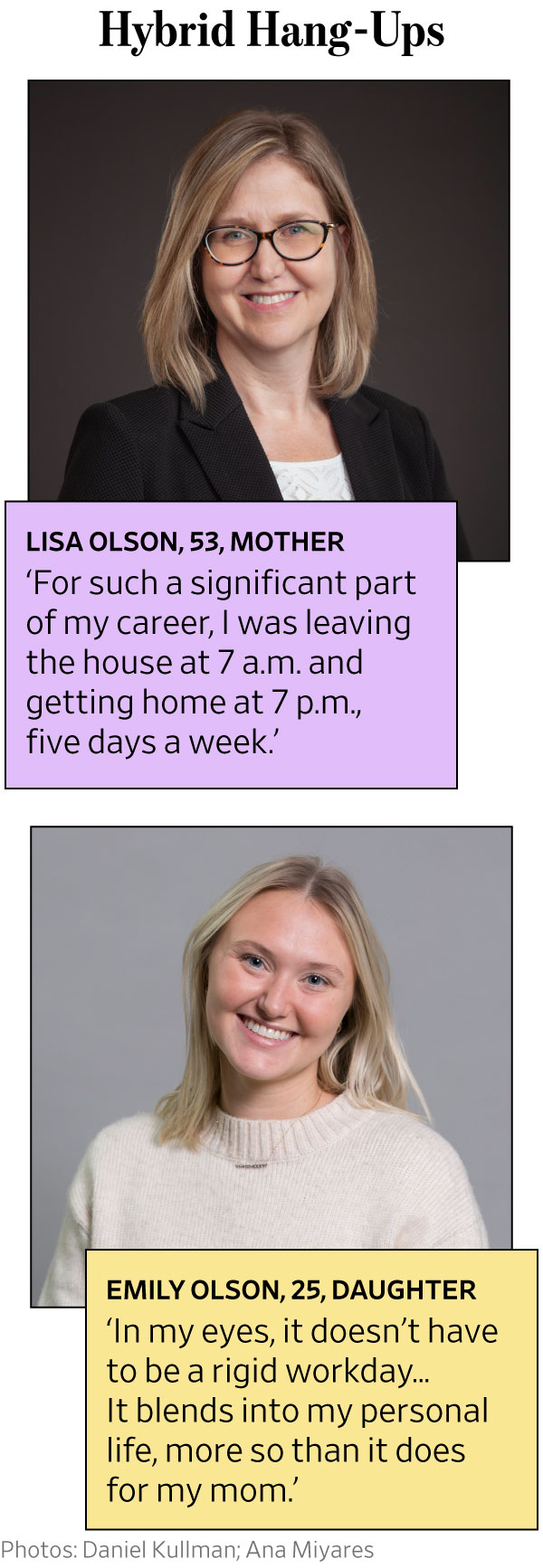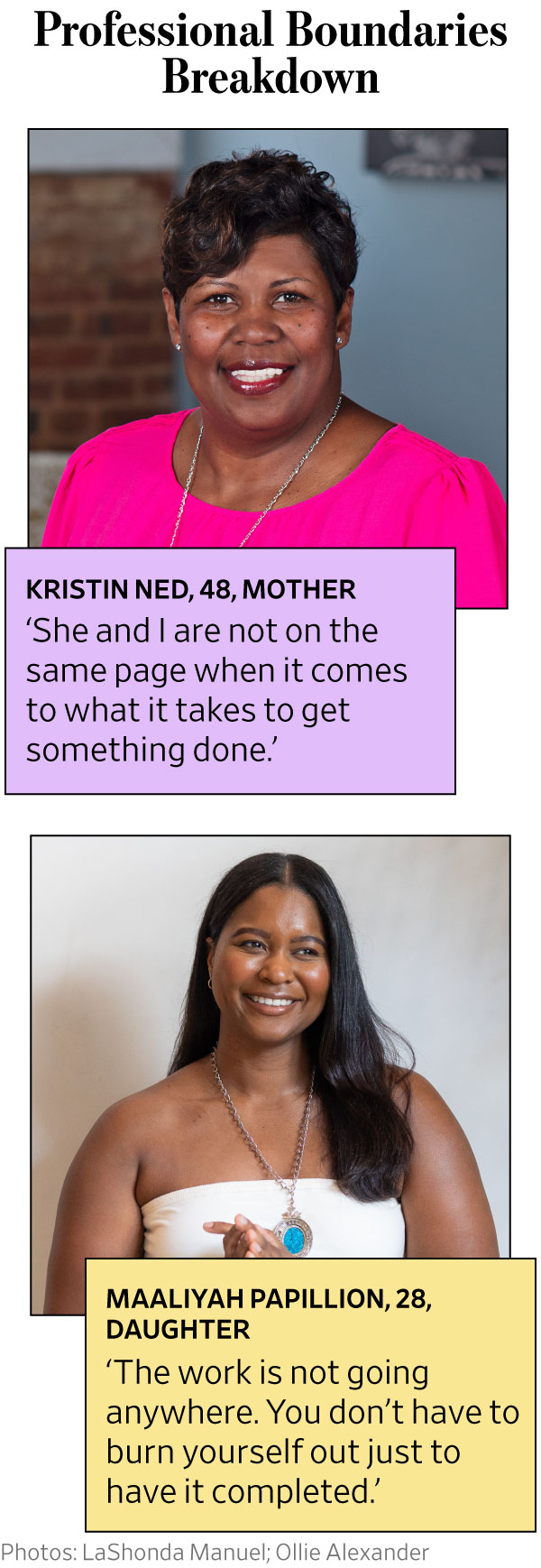The Big Family Fight Is Over How to Work. ‘They Think I’m Insane.’
Generational debates about work may be brewing in the office, but they’re often louder on the home front
Hybrid work. Hustle culture. Work-life balance.
Tensions over how to work don’t just permeate offices these days. They’re on full display within families.
“They think I’m insane,” Lisa Olson, 53, said of her children when she tells them she skipped lunch during the workday.
Her 25-year-old daughter, Emily Olson, tends to fit her job in advertising around her life, sometimes taking a midday break but also logging on after-hours if there’s work to be done. She thinks her mom struggles to make time for herself.
Like with the Olsons, many of these debates break along generational lines. Many parents in their 50s and 60s built careers in pay-your-dues work environments where 40 hours was the minimum spent in an office each week. They had clear-cut templates for getting ahead.
Their children, in contrast, joined the labor force over the past decade, as the gig economy took off, a pandemic upended 22 million jobs and millions of people embraced working from home. Technologies such as AI are scrambling their careers even more.
These debates about work are often more pointed, and personal, at home than on the job. Parents and their adult children say these conversations are often meaningful in navigating today’s multigenerational workforce.

“These are people who’ve known you all your life—you hope they understand what really matters to you,” said Megan Gerhardt, a management professor at Miami University’s Farmer School of Business and the author of a book about intergenerational workforces.
Emily has worked mostly remotely since graduating from college in 2020. One benefit is that she can integrate errands into her workday. Her mother, who works in financial services, urges her to go into the office.
“When you’re remote, you hop on a Teams call, and you talk about the issue at hand—and you don’t necessarily have extra time in that meeting to chat,” Lisa said.
Emily said that when she does commute to work, she often interacts with co-workers virtually since not all of her team lives in Chicago, where she’s based.
As long as she does good work and is responsive, working set hours in a set place isn’t important to her, she said. When a call was unexpectedly rescheduled to a Friday afternoon, when work is usually winding down, she logged on from the hair salon while getting highlights.
“It doesn’t have to be a rigid workday,” said Emily, who often works more than 40 hours each week.
Lisa, on the other hand, said she spent much of her career leaving for work at 7 a.m., and returning at 7 p.m., five days a week. “In my world, work is a completely separate item from my personal life,” she said.

Kristin Ned, 48, has logged long hours over her career in human resources, ready to respond to emergencies. Her 28-year-old daughter, Maaliyah Papillion, gives priority to rest when she’s not on the clock.
“She and I are not on the same page when it comes to what it takes to get something done,” said Ned, who lives in Lake Charles, La. “I know not everything can happen between 8 a.m. and 5 p.m.”
Papillion started an executive-assistant job this summer in New Orleans. A priority was professional boundaries, especially since she was embarking on a master’s program and had less free time.
“If work is over, work is over,” she said.
One Sunday night, Papillion got a work call. “Can it wait until tomorrow?” she replied. Later, she consulted her mom.
No one wants to make a work call on a Sunday night, Ned said, so it must have been important. Papillion said she now sees that little gestures go a long way, especially when building professional relationships.
Ned said she’s also learned from Papillion’s approach to work, such as when Ned’s company held a back-to-school campaign allowing for more work flexibility as parents adjusted to new school drop-off routines.
“We tried to make it as easy as possible,” she said.

Kendrick Hering, 24, has been patching together temporary gigs in landscaping and fixing up rental properties while he tries to launch his own business as a digital artist. His dad, Doug Hering, wants him to apply for more steady work.
Kendrick lives at home in Colorado Springs, Colo., and pays rent to his parents. He has been applying for more full- and part-time work for months, but with no luck. He also doubts full-time work would come with the job security and benefits that would make all the hustling he’s doing now worth it.
“To actually even find out about a job that I’m probably, just statistically speaking, not going to get, I have to do an exorbitant amount of research,” Kendrick said.
Doug Hering, a 63-year-old financial planner, has recommended his son apply to several jobs each day. He also has suggested he make business cards and perhaps enlist a life or business coach.
“You can’t sit back and do some digital advertising and hope that the floodgates will open,” said Doug, who took Kendrick to a networking event this month.

Lisbeth Darsh, a 57-year-old marketer based in Seattle, said her kids often encourage her to vie for promotions, so that her pay and title reflect her expertise. Her son, Justas Rodarte, 26, said his mum’s skills in writing to engage an audience are hard to match and she is better than he is at social media.
“My son is good at reminding me that there’s great value in what I do, and I owe it to myself to get that value,” Darsh said.
She’s not alone in taking advice from younger generations. About three-quarters of nearly 7,000 workers surveyed worldwide this summer said 20-something co-workers had influenced their attitudes toward issues such as work-life boundaries, fair pay and self-advocacy, according to Edelman, the public-relations firm that conducted the survey.
In the past, employers haven’t fully recognised Darsh’s skills, her son said, but this summer she won a promotion to become a director.
Now, his mum has a position that “fits her skills really well,” said Rodarte, who is pursuing a Ph.D. in immunology. “It’s the sort of thing that I wish I’ll be able to achieve.”
 Copyright 2020, Dow Jones & Company, Inc. All Rights Reserved Worldwide. LEARN MORE
Copyright 2020, Dow Jones & Company, Inc. All Rights Reserved Worldwide. LEARN MORE
Australia’s housing market defies forecasts as prices surge past pandemic-era benchmarks.
Records keep falling in 2025 as harbourfront, beachfront and blue-chip estates crowd the top of the market.
The French-Swiss watchmaker expands its aviation-inspired universe with three bold new releases, each blending advanced materials, luminous design and mechanical precision.
Bell & Ross has re-engineered its iconic BR-03 line with the launch of the BR-X3 series, a new generation of professional instrument watches designed for those who live at the edge of performance.
The new models — the BR-X3 Black Titanium, BR-X3 Blue Steel and BR-X3 Night Vision — take the brand’s signature “circle within a square” aesthetic into more experimental territory, merging technical mastery with striking design.
At the heart of the BR-X3 line is the BR-CAL.323 calibre, a self-winding mechanical movement developed by Kenissi for Bell & Ross, offering a 70-hour power reserve and COSC-certified precision.
Each piece is built around a multi-component 41 mm case that uses advanced materials including titanium, steel, carbon fibre, and luminescent resin, with a 5-year warranty across the range.
Three Takes on Flight
The BR-X3 Black Titanium focuses on lightness and strength, combining micro-blasted titanium plates with a perforated rubber strap for comfort.
The BR-X3 Blue Steel channels the colour of the stratosphere, with polished and satin-finished steel, anodised blue aluminium pillars, and a sunray blue dial inspired by space flight.
Completing the trilogy, the BR-X3 Night Vision pushes into nocturnal territory, its LUM-CAMO carbon-fibre case infused with photoluminescent resin for readability in total darkness — a 250-piece limited edition referencing the green glow of aircraft head-up displays.

A Partnership Born in the Skies
Unveiled at the 2025 Paris Air Show, Bell & Ross became the official partner of the Rafale Solo Display, the French Air and Space Force’s official flight demonstration unit.
To mark the collaboration, the brand released the BR-03 Chrono Rafale Solo Display, a 500-piece limited edition that embodies the precision and performance of the fighter jet it honours.
Housed in a 42 mm micro-blasted black ceramic case, the chronograph features the BR-CAL.301 automatic movement with a 42-hour power reserve.
Its matte black dial incorporates aviation-inspired details — a yellow dotted line around the date window, orange chronograph hands, and the Rafale Solo Display insignia.
The watch comes on a black rubber or ultra-resilient fabric strap, both built for durability under extreme conditions.

Precision Meets Passion
Since its founding in 1994 by Carlos-A. Rosillo and Bruno Belamich, Bell & Ross has built its identity around precision timekeeping for professionals — from fighter pilots to deep-sea divers.
The BR-X3 and BR-03 Chrono Rafale Solo Display extend that lineage, fusing experimental design with the technical sophistication expected of modern instrument watches.
For collectors and aviation enthusiasts alike, these new releases represent Bell & Ross at its most daring — and most authentic — where mechanical innovation meets the thrill of flight.
From Italy’s $93,000-a-night villas to a $20,000 Bowral château, a new global ranking showcases the priciest Airbnbs available in 2026.
On October 2, acclaimed chef Dan Arnold will host an exclusive evening, unveiling a Michelin-inspired menu in a rare masterclass of food, storytelling and flavour.






















